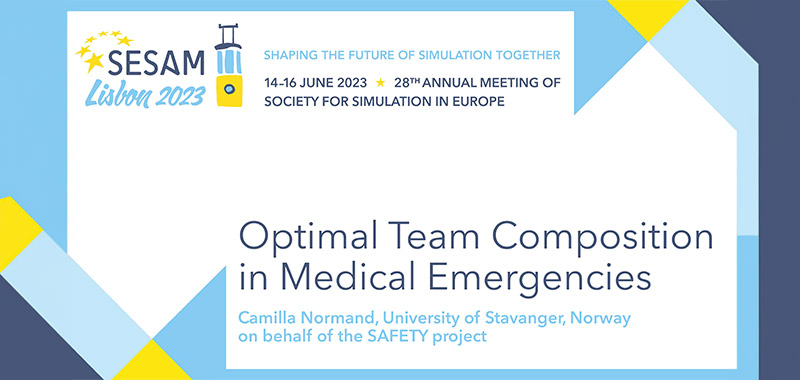
The Society for Simulation in Europe (SESAM) held its annual conference in Lisbon from the 14th to the 16th of June. (SESAM Lisbon 2023 | SESAM (sesam-web.org))
Camilla Normand from the University of Stavanger represented the SAFETY group. She presented an abstract on optimal team composition in emergency treatment.
Resuscitation simulation training has been shown to improve interdisciplinary team performance, which in turn leads to improved patient outcome. To optimize the benefits of simulation training, it is essential that we identify the optimal composition of resuscitation teams so that we can reproduce these in training.
As part of the ERASMUS+ project ‘Simulation Approach For Education and Training in emergencY (SAFETY)’ we have reviewed the current scientific literature and performed a systematic review to answer the question – what is the optimal team composition in medical emergencies?
We searched the databases Embase, Medline and PsycInfo using the terms: team, trauma team, healthcare, treatment, emergency, medicine, and centre.
These searches lead to 1728 articles and after full-text screening 17 articles were included in the analysis.
We found no article describing optimal team composition for emergency training. All the reviewed articles described real life treatment, not simulation.
Furthermore, based on published papers on clinical practices, there appears to be “several roads to Rome” regarding the optimal team composition in an emergency resuscitation. Some hospitals advocate a large team while others manage with a smaller team. The minimum team described, a rapid response team, appears to require only two members, a doctor team leader and a nurse.
Most of the literature refers to trauma teams. Here the consensus is that a basic trauma team should consist of at least a team leader, one or two emergency nurses, a radiology technician and, preferably, an anaesthetist. Our review also shows that a trauma team needs a team leader but that this leader may not need to be a surgeon or even a doctor. Specialized team compositions are required for paediatric patients and acute stroke patients but again there are local variations.
In our search through the literature for the optimal team composition to deal with emergencies, we have therefore discovered variations on how to treat these emergencies efficiently. What is clearly lacking is any discussion of the optimal team composition for training in emergency medicine. In our literature search, we found no article on this topic. This leads us to assume that the “characters” used in simulation for training in emergencies are based on real life rather than on what would be required for the optimal training scenario. While this is a sensible approach, it does not answer our key question: what is the optimal team composition of training in medical emergencies?
Camilla Normand, UiS team, on behalf of the SAFETY project



